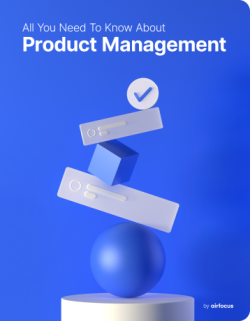Customer-Driven Product Management
Instead of creating a product with only the opinions of internal team members and stakeholders as guidelines, Customer-Driven Product Management builds every aspect of the product around what they have learned about their ideal customers.
This approach to product management also works to strengthen the communication and collaboration between internal sales, service, and development teams, as the insights gained by one team need to be shared and understood by all internal team personnel. A Customer-Focused Product Manager would be the team member assigned to overseeing this wide-scale collaboration.
What is Customer-Driven Product Management used for?
Next to Product-Driven Product Management, Customer-Driven Product Management is used to better understand the customer journey and create a better-performing product.
This process is generally broken down into four action steps:
1. Identifying customer biases
Rather than using the internal team’s inherent assumptions and biases about a given market, identifying these biases and where they come from is a key first step when embarking on any Customer-Driven Product Management approach.
This means that, instead of relying on generalities or vague ideas on what your target market needs, conducting an analysis of market conditions is a must. That ensures that you’re drawing inspiration from facts, not assumptions.
2. Interviewing your target audience
By interviewing several members of your target audience, you can create a streamlined customer journey (and, in turn, end product) that represents the standard customer experience.
This involves thoroughly understanding their needs, pain points, and preferences.
This step should answer the following questions:
What problems is your product going to solve for your target audience?
How have your customers tried to solve this problem on their own?
What are your competitors lacking that would turn these customers towards your product instead?
3. Reporting on customer experiences
Observing and reporting on customer experiences in real-time will provide you and your team with the first-hand knowledge necessary to create a product that succinctly solves the challenges they face.
Which parts of the experience are frustrating or confusing? Which steps of the customer journey makes them lose interest in the product or hesitate about their purchase? By observing and reporting on this information, you can refine both your product and the general customer journey.
4. Collaborating with your customers
With the previous stages behind you, it’s important to continue collaborating with customers throughout the design process.
While this does not mean having customers design the product in lieu of your team, it does mean keeping a feedback loop open. You want to know how likely they are to use the product in its current iteration, how intuitive they find the product to be, and if there are any areas of the product that they find confusing or lacking.
During this final step, customer opinions make it so you know you are launching a finished product that accurately and easily meets the needs of your ideal audience.
The challenges of Customer-Driven Product Management
Customer-Driven Product Management requires a significant time investment, discipline regarding keeping wide-scale collaboration at the forefront of every design decision, and humility.
While bringing a product to market may seem comparatively easy when customer feedback isn’t factored in, the enhanced accuracy and product-effectiveness it provides make the potential challenges more than worthwhile.
General FAQ

Glossary categories
Experience the new way of doing product management

Experience the new way of doing product management








